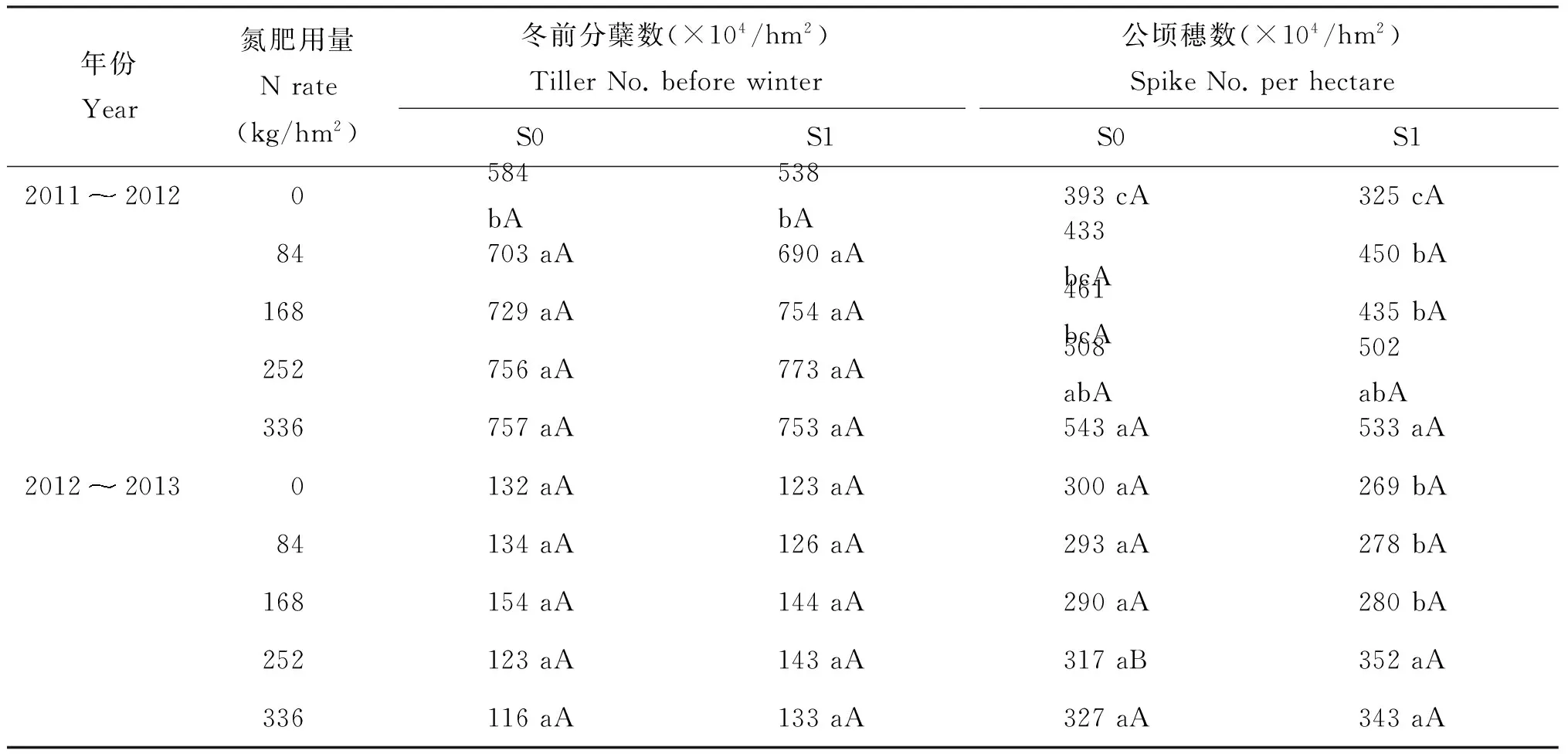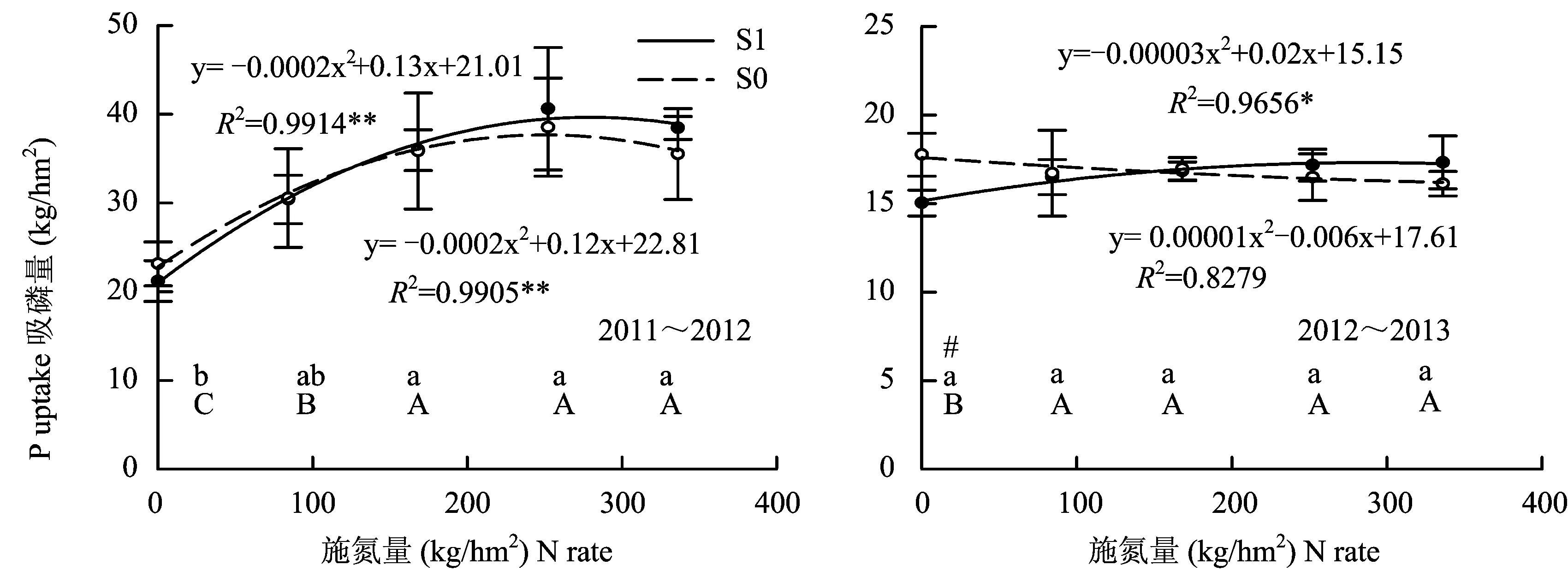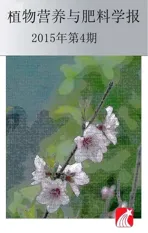秸秆还田对冬小麦产量和氮、磷、钾吸收利用的影响
2015-06-12黄婷苗郑险峰侯仰毅王朝辉
黄婷苗, 郑险峰*, 侯仰毅 , 李 晓, 王朝辉, 2
(1西北农林科技大学资源环境学院/农业部西北植物营养与农业环境重点实验室,陕西杨凌 712100;2西北农林科技大学, 旱区作物逆境生物学国家重点实验室,陕西杨凌 712100)
秸秆还田对冬小麦产量和氮、磷、钾吸收利用的影响
黄婷苗1, 郑险峰1*, 侯仰毅1, 李 晓1, 王朝辉1, 2
(1西北农林科技大学资源环境学院/农业部西北植物营养与农业环境重点实验室,陕西杨凌 712100;2西北农林科技大学, 旱区作物逆境生物学国家重点实验室,陕西杨凌 712100)

秸秆还田; 冬小麦; 产量; 养分吸收; 养分调控

1 材料与方法
1.1 试验时间、地点

图1 2011年7月2013年5月试验地点降水量Fig.1 The monthly precipitation from July 2011 to May 2013 at the experimental site[注(Note): 资料来源于周至县气象局 Data from Meteorological Administration of Zhouzhi County, Shaanxi Province.]
1.2 试验设计

1.3 测定项目与方法
1.3.1 土壤样品 试验开始前(2011年10月),采用5点混合法取0—20 cm土层基础土样,风干后分别过1 mm和0.25 mm筛。有机质含量用油浴加热—重铬酸钾容量法;全氮用浓硫酸消煮—半微量开氏法;硝态氮用1 mol/L氯化钾浸提—连续流动分析仪测定;有效磷用0.5 mol/L碳酸氢钠提取—钼锑抗比色法;速效钾用1 mol/L乙酸铵提取—火焰光度法;pH(水土比为2.5 ∶1)用电位法;土壤容重用环刀法测定[17]。
1.3.2 植株样品 于冬小麦出苗后在各小区随机选取3个1 m长的样段,并标记,用于调查小麦田间分蘖数。在成熟期(2012年6月5日,2013年5月27日)采集植株样品,各小区随机选取3个1 m2具有代表性的样点,风干后用脱粒机脱粒、称重;取部分籽粒样品,于65℃烘干至恒重,测定水分含量,计算小麦籽粒产量。同时,每个小区随机采集3个1 m长的样段混合后,沿根茎结合处剪掉根系,将地上部作为一个分析样品,风干后分为籽粒、茎叶和颖壳三部分,分别称重后,各取部分样,于65℃烘干至恒重,计算各处理小麦收获指数。各部位烘干样粉碎后,用浓H2SO4-H2O2消煮,AA3连续流动分析仪测定氮、磷含量,火焰光度计测定钾含量。小麦籽粒氮、磷、钾含量,产量和生物量均以65℃烘干后的干物质量表示。
1.4 数据处理
地上部吸氮(磷、钾)量(kg/hm2)=[籽粒含氮(磷、钾)量(g/kg)×籽粒产量(kg/hm2)+茎叶含氮(磷、钾)量(g/kg)×茎叶生物量(kg/hm2)+颖壳含氮(磷、钾)量(g/kg)×颖壳生物量(kg/hm2)]/1000
氮(磷、钾)收获指数(%)=籽粒吸氮(磷、钾)量(kg/hm2)/地上部吸氮(磷、钾)量(kg/hm2)×100[18]
试验数据用Excel 2007进行处理,SAS 8.1软件进行方差分析,作图工具为Sigmaplot 12.0。

图2 玉米秸秆还田对冬小麦籽粒产量的影响Fig.2 Effects of the maize straw return to soil on grain yield of winter wheat[注(Note): S0—玉米秸秆不还田Without maize straw return; S1—玉米秸秆还田With maize straw return. 图中不同小、大写字母分别表示秸秆不还田和秸秆还田条件下氮水平间的差异达5%显著水平Different small and capital letters indicate differences among different N rates at the 5% level under the straw removal treatments and straw return to soil treatments, respectively.]
2 结果与分析
2.1 小麦籽粒产量
对小麦产量和施氮量的回归分析(图2)发现,秸秆还田与不还田的肥料效应曲线相交,与不还田相比,秸秆还田小麦有低施氮量减产、高氮量时增产的趋势。第一年,施氮量低于N 153 kg/hm2时,秸秆还田处理的产量低于不还田处理,不施氮时,秸秆还田的籽粒产量为3427 kg/hm2,比不还田处理减少3.0%,当施氮量高于N 153 kg/hm2时,秸秆还田处理的小麦产量增加,施氮量252和336 kg/hm2时,产量分别为7077和7320 kg/hm2,比不还田处理增加3.2%和7.2%。第二年,两条曲线交点处施氮量为N 187 kg/hm2,不施氮肥时,秸秆还田的小麦产量为4317 kg/hm2,比不还田减产8.4%;施氮量为N 252和336 kg/hm2时,小麦产量分别为5801和5833 kg/hm2,比不还田处理增加2.4%和5.6%。由此可见,秸秆还田后小麦是否增产受氮肥用量的影响。秸秆还田与不还田两个处理的产量曲线相交,施氮量低于交点值时,秸秆还田小麦减产;高于此值则增产,且增产量随着氮肥用量的增大更加明显。
2.2 小麦生物量
对生物量与施氮量进行回归分析,其结果(图3)表明,秸秆还田对小麦生物量的影响与产量有相似的趋势,即低氮降低、高氮增加。第一年,施氮量低于N 190 kg/hm2时,秸秆还田的小麦生物量降低,高于N 190 kg/hm2时,生物量增加。不施氮肥和施纯氮N 84 kg/hm2时,秸秆还田处理的生物量分别为9634和13032 kg/hm2,比不还田处理降低5.0%和3.5%;施氮量提高到N 336 kg/hm2时,生物量为17732 kg/hm2,比不还田处理增加8.9%。第二年,施氮量为N 202 kg/hm2时,秸秆还田与不还田的小麦生物量(10811 kg/hm2)相等,不施氮肥时,秸秆还田的小麦生物量为8068 kg/hm2,比不还田处理降低11.3%,差异达显著水平;施氮量为N 336 kg/hm2时,比不还田处理增加5.6%。可见,要使秸秆还田条件下的生物量高于不还田,氮肥用量应不低于N 190 kg/hm2。
对小麦收获指数的分析表明,秸秆还田与否没有显著影响,但低施氮量(N 0和84 kg/hm2)时,秸秆还田的小麦收获指数有增加趋势。施氮量为N 0、 84、 168、 252和336 kg/hm2时,第一年秸秆还田和不还田的小麦收获指数分别为35.6%、39.4%、40.9%、41.4%、41.3%和34.9%、38.6%、40.4%、41.4%、42.0%,第二年分别为53.5%、53.1%、52.7%、52.2%、51.6%和51.8%、52.2%、52.2%、52.0%和51.6%。说明秸秆还田条件下,施氮量不足N 168 kg/hm2时,由于氮素相对缺乏,小麦生长受到抑制,会将有限的干物质更多地向籽粒转移。

图3 玉米秸秆还田对冬小麦生物量的影响Fig.3 Effects of the maize straw return to soil on biomass of winter wheat[注(Note): 图中不同小、大写字母分别表示秸秆不还田和秸秆还田条件下氮水平间的差异达5%显著水平Different small and capital letters indicate differences among different N rates at the 5% level under the straw removal treatments and straw return to soil treatments, respectively. “#”表示同一氮水平玉米秸秆还田与不还田处理间差异达到5%显著水平 Indicates that the differences between the maize straw return to soil and straw removal treatments under the same N rate at the 5% level. S0—玉米秸秆不还田Without maize straw return; S1—玉米秸秆还田With maize straw return.]
2.3 小麦冬前分蘖与产量构成要素
表1表明,秸秆还田对小麦冬前分蘖和公顷穗数的影响也呈现出低氮降低,高氮增加的趋势,在试验的第2年更为明显。第一年,不施氮秸秆还田处理的冬前分蘖和公顷穗数分别比不还田处理降低7.9%和17.3%,第二年,不施氮肥和施氮量N 84 kg/hm2时,冬前分蘖分别降低6.8%和6.0%,公顷穗数分别降低10.3%和5.1%,但当施氮量增至N 252 kg/hm2时,小麦穗数比不还田处理增加11.0%,差异达显著水平。

2.4 小麦籽粒氮、磷、钾含量


表1 小麦冬前分蘖数和公顷穗数Table 1 Tiller number before winter and spike number per hectare
注(Note): S0—玉米秸秆不还田Without maize straw return; S1—玉米秸秆还田With maize straw return. 同行数据后不同大写字母表示玉米秸秆还田与不还田的差异达5%显著水平 Values followed by different capital letters in same row are significantly different between treatments of the maize straw return to soil or not at the 5% level in the same year; 同列数据后不同小写字母表示氮水平间的差异达5%显著水平Values followed by different small letters in a column are significantly different among different N rates at the 5% level.

表2 小麦籽粒氮、磷、钾含量(g/kg)Table 2 Nitrogen, phosphorus and potassium contents in wheat grain
注(Note): S0—玉米秸秆不还田Without maize straw return; S1—玉米秸秆还田With maize straw return. 同行数据后不同大写字母表示玉米秸秆还田与不还田的差异达5%显著水平Values followed by different capital letters in same row are significantly different between treatments of the maize straw return to soil or not at the 5% level in the same year; 同列数据后不同小写字母表示氮水平间的差异达5%显著水平Values followed by different small letters in a column are significantly different among different N rates at the 5% level.

2.5 小麦氮素吸收与利用
从图4可以看出,在低氮量时,秸秆还田较秸秆不还田处理的小麦地上部吸氮量降低,施氮量高时则相反。前后两年氮肥用量分别低于N 275和200 kg/hm2时,秸秆还田的小麦吸氮量低于不还田;第一年,施氮量为N 168 kg/hm2时,小麦吸氮量比不还田处理显著降低13.6%,第二年不施氮肥和施氮N 84 kg/hm2时,分别降低8.2%和5.4%。两年氮肥用量分别高于N 275和200 kg/hm2时,秸秆还田的小麦吸氮量增加,施氮N 336 kg/hm2时,第一年和第二年的吸氮量分别比不还田处理增加6.4%和10.3%。可见,由于还田的秸秆腐解需要消耗一部分氮素,导致小麦地上部吸氮量降低、氮素累积下降,但施氮量充足时,这一影响不仅可以消除,秸秆还田还能促进小麦吸收更多的氮素。

图4 玉米秸秆还田对冬小麦地上部吸氮量的影响Fig.4 Effects of the maize straw return to soil on nitrogen uptake in aboveground of winter wheat[注(Note): 图中不同小、大写字母分别表示秸秆不还田和秸秆还田条件下氮水平间的差异达5%显著水平 Different small and capital letters indicate differences among different N rates at the 5% level under the straw removal treatments and straw return to soil treatments, respectively. “#”表示同一氮水平玉米秸秆还田与不还田处理间差异达到5%显著水平 Indicates that the differences among means of the maize straw return to soil and straw removal treatments under the same N rate at the 5% level. S0—玉米秸秆不还田Without maize straw return; S1—玉米秸秆还田With maize straw return.]
试验结果还表明,秸秆还田的氮收获指数在低施氮量时增加,施氮量高时无差异。第一年秸秆还田和不还田不同施氮水平的氮素收获指数分别为78.1%、81.4%、79.7%、79.1%、79.0%和73.9%、78.9%、82.2%、78.3%、76.0%,第二年分别为82.3%、82.4%、79.5%、79.1%、79.2%和80.9%、80.0%、80.1%、79.1%、79.6%。说明施氮量低时,作物氮素营养不足,秸秆还田小麦将更多的氮素转向籽粒,以保证籽粒正常生长所需的氮营养。
2.6 小麦磷素吸收与利用

秸秆还田对磷的收获指数亦无显著影响,但施氮量较低(N 0和84 kg/hm2)时,与不还田相比,秸秆还田的磷收获指数有增加趋势。随着施氮量的增加,第一年,秸秆还田和不还田的磷收获指数分别为69.0%、75.0%、74.0%、78.4%、80.7%和67.0%、73.4%、74.5%、77.6%、79.1%,第二年分别为89.1%、87.6%、87.3%、87.2%、86.6%和87.1%、87.0%、87.1%、87.8%、86.1%。

图5 玉米秸秆还田对冬小麦地上部吸磷量的影响Fig.5 Effects of the maize straw return to soil on phosphorus uptake in aboveground of winter wheat[注(Note): 图中不同小、大写字母分别表示秸秆不还田和秸秆还田条件下氮水平间的差异达5%显著水平 Different small and capital letters indicate differences among different N rates at the 5% level under the straw removal treatments and straw return to soil treatments, respectively. “#”表示同一氮水平玉米秸秆还田与不还田处理间差异达到5%显著水平 Indicates that the differences among means of the maize straw return to soil and straw removal treatments under the same N rate at the 5% level. S0—玉米秸秆不还田Without maize straw return; S1—玉米秸秆还田With maize straw return.]
2.7 小麦钾素吸收与利用

图6 玉米秸秆还田对冬小麦地上部吸钾量的影响Fig.6 Effects of the maize straw return to soil on potassium uptake in aboveground of winter wheat[注(Note): 图中不同小、大写字母分别表示秸秆不还田和秸秆还田条件下氮水平间的差异达5%显著水平Different small and capital letters indicate differences among different N rates at the 5% level under the straw removal treatments and straw return to soil treatments, respectively. S0—玉米秸秆不还田Without maize straw return; S1—玉米秸秆还田With maize straw return.]

低氮时秸秆还田处理的钾收获指数增加,尤其在试验持续到第二年时更加明显,高氮量时无显著影响。不同氮水平时,第一年秸秆还田与不还田的钾收获指数分别为16.4%、15.5%、13.1%、16.3%、13.8%和15.1%、15.1%、15.4%、12.8%、12.5%,第二年分别为21.2%、21.6%、19.4%、18.5%、17.5%和19.9%、19.6%、19.5%、18.4%、17.2%。说明施氮量低时,秸秆还田的小麦茎叶中钾素残留减少,向籽粒转移的比例增加。
3 讨论
3.1 秸秆还田的小麦产量及其构成要素

在产量构成要素中,同一施氮水平时,秸秆还田对小麦的穗粒数和千粒重没有明显影响,而穗数表现为低氮量下减少,施氮量高时增加,与产量的变化趋势一致。说明公顷穗数变化是影响秸秆还田小麦产量的直接原因。主要是因为氮素不足时,在小麦生长前期,如有新鲜有机物的加入,使微生物活动加强,土壤养分过度消耗,后期氮素供应不足,导致形成的无效分蘖增多、有效穗数降低[20];氮素充足时,不仅满足了微生物分解秸秆需要的氮素,充足的氮素也可保障小麦正常生长,穗数增加。在山东泰安的试验发现,施氮量较高时(N 240 kg/hm2),玉米秸秆还田耙耕处理小麦穗数增加6.7%,产量增加4.7%[21]。因此,玉米秸秆还田条件下,根据目标产量,同时应补充供微生物活动和作物正常生长需要的氮素,是获得小麦增产的关键。
3.2 秸秆还田小麦籽粒氮磷钾含量及其吸收利用
本试验中,秸秆还田对小麦籽粒氮磷钾含量均无明显影响,但第一年施氮量分别低于N 275、123和213 kg/hm2,第二年分别低于N 200、165和241 kg/hm2时,秸秆还田小麦氮、磷、钾吸收量降低,超过这一施氮量时,氮磷钾吸收量增加。河南小麦玉米轮作试验发现,不施氮肥,秸秆还田小麦地上部吸氮量降低7.6%,施氮量提高到N 270和360 kg/hm2时,地上部吸氮量分别增加5.5%和7.9%[10]。印度西北部田间试验也证明,稻草不还田、推荐施氮N 120 kg/hm2时,还田小麦吸氮量降低9.8%,氮肥利用率降低21%[22]。可见,由于秸秆腐解需要消耗氮素,氮肥不足时,土壤中可利用的氮素减少,抑制了作物地上部氮的吸收和累积。氮磷、氮钾间也存在明显的正交互作用[23],氮素不足导致小麦磷钾吸收降低。氮肥充足时,一方面可为土壤提供足够的养分“源”[24],另一方面,可促进对磷钾吸收[25-26]。本研究发现,低氮时秸秆还田有增加氮磷钾收获指数的趋势。说明生长后期土壤氮素供应不足、难以满足作物的氮营养需求时,小麦会将吸收的养分更多地从茎秆转运到籽粒。田间水稻试验也发现,不施氮肥时,与小麦秸秆不还田相比,秸秆还田能显著提高水稻氮磷钾收获指数[27]。
3.3 秸秆还田小麦增产高效的养分调控

4 结论

[1] 李逢雨, 孙锡发, 冯文强, 等. 麦秆、油菜秆还田腐解速率及养分释放规律[J]. 植物营养与肥料学报, 2009, 15(2): 374-380. Li F Y, Sun X F, Feng W Qetal. Nutrient release patterns and decomposing rates of wheat and rapeseed straw[J]. Plant Nutrition and Fertilizer Science, 2009, 15(2): 374-380.
[2] 谭德水, 金继运, 黄绍文, 等. 不同种植制度下长期施钾与秸秆还田对作物产量和土壤钾素的影响[J]. 中国农业科学, 2007, 40(1): 133-139. Tan D S, Jin J Y, Huang S Wetal. Effect of long-term application of K fertilizer and wheat straw to soil on crop yield and soil K under different planting systems[J]. Scientia Agricultura Sinica, 2007, 40(1): 133-139.
[3] Malhi S S, Lemke R. Tillage, crop residue and N fertilizer effects on crop yield, nutrient uptake, soil quality and nitrous oxide gas emissions in a second 4-yr rotation cycle[J]. Soil & Tillage Research, 2007, 96(1-2): 269-283.
[4] 王改玲, 郝明德, 徐继光, 洪坚平. 保护性耕作对黄土高原南部地区小麦产量及土壤理化性质的影响[J]. 植物营养与肥料学报, 2011, 17(3): 539-544. Wang G L, Hao M D, Xu J G, Hong J P. Effect of conservation tillage on wheat yield and soil physicochemical properties in the south of Loess Plateau[J]. Plant Nutrition and Fertilizer Science, 2011, 17(3): 539-544.
[5] 董勤各, 冯浩, 杜键. 秸秆粉碎还田与化肥配施对冬小麦产量和水分利用效率的影响[J]. 农业工程学报, 2010, 26 (增刊2): 156-162. Dong Q G, Feng H, Du J. Effects of chemical fertilizer combined crushed straw application on yield and water use efficiency of winter wheat[J]. Transactions of the CSAE, 2010, 26 (Supp.2): 156-162.
[6] Powlson D S, Jenkinson D S, Pruden G, Johnston A E. The effect of straw incorporation on the uptake of nitrogen by winter wheat[J]. Journal of the Science of Food and Agriculture, 1985, 36: 26-30.
[7] 郑伟, 张静, 刘阳, 等. 低施肥条件下秸秆还田对冬小麦旗叶衰老的影响[J]. 生态学报, 2009, 29(9): 4967-4975. Zheng W, Zhang J, Liu Yetal. Physiological effects of ploughing corn straw under soil on flag-leaf resistance of winter wheat under lowly applying fertilizer condition[J]. Acta Ecologica Sinica, 2009, 29(9): 4967-4975.
[8] 李少昆, 王克如, 冯聚凯, 等. 玉米秸秆还田与不同耕作方式下影响小麦出苗的因素[J]. 作物学报, 2006, 32(3): 463-465. Li S K, Wang K R, Feng J Ketal. Factors affecting seeding emergence in winter wheat under different tillage patterns with maize stalk mulching returned to the field[J]. Acta Agronomica Sinica, 2006, 32(3): 463-465.
[9] 刘义国, 林琪, 王宁. 秸秆还田与氮供应对小麦灌浆期光合日变化的影响[J]. 华北农学报, 2013, 28(5): 219-223. Liu Y G, Lin Q, Wang N. Effects of straw return and N supply on diurnal variation of photosynthesis in grain filling stage of wheat[J]. Acta Agriculturae Boreali-Sinica, 2013, 28(5): 219-223.
[10] 赵鹏, 陈阜. 秸秆还田配施化学氮肥对冬小麦氮效率和产量的影响[J]. 作物学报, 2008, 34(6): 1014-1018. Zhao P, Chen F. Effects of straw mulching plus nitrogen fertilizer on nitrogen efficiency and grain yield in winter wheat[J]. Acta Agronomica Sinica 2008, 34(6): 1014-1018.
[11] Lemke R L, VandenBygaart A J, Campbell C AetalCrop residue removal and fertilizer N: Effects on soil organic carbon in a long-term crop rotation experiment on a Udic Boroll[J]. Agriculture, Ecosystems and Environment, 2010, 135(1-2): 42-51.
[12] Roldan A, Caravaca F, Hernández M Tetal. No-tillage, crop residue additions, and legume cover cropping effects on soil quality characteristics under maize in Patzcuaro watershed (Mexico)[J]. Soil & Tillage Research, 2003, 72: 65-73.
[13] Fuentes M, Govaerts B, De León Fetal. Fourteen years of applying zero and conventional tillage, crop rotation and residue management systems and its effect on physical and chemical soil quality[J]. European Journal of Agronomy, 2009, 30: 228-237.
[14] 张鹏, 李涵, 贾志宽, 等. 秸秆还田对宁南旱区土壤有机碳含量及土壤碳矿化的影响[J]. 农业环境科学学报, 2011, 30(12): 2518-2525. Zhang P, Li H, Jia Z Ketal. Effects of straw returning on soil organic carbon and carbon mineralization in semi-arid areas of southern Ningxia, China[J]. Journal of Agro-Environment Science, 2011, 30(12): 2518-2525.
[15] 王龙昌, 邹聪明, 张云兰, 等. 西南“旱三熟”地区不同保护性耕作措施对农田土壤生态效应及生产效应的影响[J]. 作物学报, 2013, 39(10): 1880-1890. Wang L C, Zou C M, Zhang Y Letal. Influences of conservation tillage practices on farmland soil ecological factors and productive benefits in dryland region with triple cropping system in southwest China[J]. Acta Agronomica Sinica, 2013, 39(10): 1880-1890.
[16] 沈海军. 秸秆还田和施氮量对关中灌区冬小麦产量形成和养分利用的影响[D]. 杨凌: 西北农林科技大学硕士学位论文, 2012. Shen H J. Effect of straw return and nitrogen fertilizer application on yield formation of winter wheat and nutrition use in Guanzhong irrigation area[D]. Yangling: Ms Thises of Northwest Agriculture and Forestry University, 2012.
[17] 鲍士旦. 土壤农化分析[M]. 北京: 中国农业出版社, 2000. 56-57, 81-83, 106-107. Bao S D. Soil agricultural-chemical analysis[M]. Beijing: China Agriculture Press, 2000. 56-57, 81-83, 106-107.
[18] 李鸿伟, 杨凯鹏, 曹转勤, 等. 稻麦连作中超高产栽培小麦和水稻的养分吸收与积累特征[J]. 作物学报, 2013, 39(3): 464-477. Li H W, Yang K P, Cao Z Qetal. Characteristics of nutrient uptake and accumulation in wheat and rice with continuous cropping under super-high-yielding cultivation[J]. Acta Agronomica Sinica, 2013, 39(3): 464-477.
[19] Limon-Ortega A, Sayre K D, Francis C A. Wheat and maize yields in response to straw management and nitrogen under a bed planting system[J]. Agronomy Journal, 2000, 92: 295-302.
[20] 张定一, 党建友, 王姣爱, 等. 施氮量对不同品质类型小麦产量、品质和旗叶光合作用的调节效应[J]. 植物营养与肥料学报, 2007, 13(4): 535-542. Zhang D Y, Dang J Y, Wang J Aetal. Regulative effect of nitrogen fertilization on grain yield, quality and photosynthesis of flag leaves in different wheat varieties[J]. Plant Nutrition and Fertilizer Science, 2007, 13(4): 535-542.
[21] 韩宾, 李增嘉, 王芸, 等. 土壤耕作及秸秆还田对冬小麦生长状况及产量的影响[J]. 农业工程学报, 2007, 23(2): 48-53. Han B, Li Z J, Wang Yetal. Effects of soil tillage and returning straw to soil on wheat growth status and yield[J]. Transactions of the CSAE, 2007, 23(2): 48-53.
[22] Bijay-Singh, Bronson K F, Yadvinder-Singhetal. Nitrogen-15 balance as affected by rice straw management in a rice-wheat rotation in northwest India[J]. Nutrient Cycling in Agroecosystems, 2001, 59: 227-237.
[23] 田生昌, 马建军, 叶路明. 宁夏平罗春小麦氮、磷、钾肥肥效及适宜用量[J]. 宁夏大学学报 (自然科学版), 2012, 33(4): 396-399. Tian S C, Ma J J, Ye L M. Spring wheat N-P-K fertilizer efficiency and the appropriate amount for Pingluo in ningxia[J]. Journal of Ningxia University (Natural Science Edition), 2012, 33(4): 396-399.
[24] 袁玲, 张宣, 杨静, 等. 不同栽培方式和秸秆还田对水稻产量和营养品质的影响[J]. 作物学报, 2013, 39(2): 350-359. Yuan L, Zhang X, Yang Jetal. Effects of different cultivation methods and straw incorporation on grain yield and nutrition quality of rice[J]. Acta Agronomica Sinica, 2013, 39(2): 350-359.
[25] Witt C, Cassman K G, Olk D Cetal. Crop rotation and residue management effects on carbon sequestration, nitrogen cycling and productivity of irrigated rice systems[J]. Plant and Soil, 2000, 225: 263-278.
[26] 杨长明, 杨林章, 颜廷梅, 欧阳竹. 不同肥料结构对水稻群体干物质生产及养分吸收分配的影响[J]. 土壤通报, 2004, 35(2): 199-202. Yang C M, Yang L Z, Yan T M, Ouyang Z. Effects of nutrient regimes on dry matter production and nutrient uptake and distribution by rice plant[J]. Chinese Journal of Soil Science, 2004, 35(2): 199-202.
[27] 徐国伟, 杨立年, 王志琴, 等. 麦秸还田与实施氮肥管理对水稻氮磷钾吸收利用的影响[J]. 作物学报, 2008, 34(8): 1424-1434. Xu G W, Yang L N, Wang Z Qetal. Effects of wheat-residue application and site-specific nitrogen management on absorption and utilization of nitrogen, phosphorus, and potassium in rice plants[J]. Acta Agronomica Sinica, 2008, 34(8): 1424-1434.
[28] 王立刚, 李虎, 杨黎, 等. 冬小麦/夏玉米轮作系统不同施氮量的长期环境效应及区域氮调控模拟[J]. 中国农业科学, 2013, 46(14): 2932-2941. Wang L G, Li H, Yang Letal. Simulation of long-term and regional environmental effects of different N applications in the winter wheat/summer maize system[J]. Scientia Agricultura Sinica, 2013, 46(14): 2932-2941.
[29] 王春阳, 周建斌, 郑险峰, 李生秀. 不同栽培模式对小麦-玉米轮作体系土壤硝态氮残留的影响[J]. 植物营养与肥料学报, 2007, 13(6): 991-997. Wang C Y, Zhou J B, Zheng X F, Li S X. Effects of different cultivation methods on soil residual nitrate under winter wheat-summer maize cropping system[J]. Plant Nutrition and Fertilizer Science, 2007, 13(6): 991-997.
[30] 同延安, 赵营, 赵护兵, 樊红柱. 施氮量对冬小麦氮素吸收、转运及产量的影响[J]. 植物营养与肥料学报, 2007, 13(1): 64-69. Tong Y A, Zhao Y, Zhao H B, Fan H Z. Effect of N rates on N uptake, transformation and the yield of winter wheat[J]. Plant Nutrition and Fertilizer Science, 2007, 13(1): 64-69.
Yield and N, P and K uptake and utilization of winter wheat affected by straw return to soil
HUANG Ting-miao1, ZHENG Xian-feng1*, HOU Yang-yi1, LI Xiao1, WANG Zhao-hui1,2
(1CollegeofNaturalResourcesandEnvironment,NorthwestA&FUniversity/KeyLaboratoryofPlantNutritionandAgro-environmentinNorthwestChina,MinistryofAgriculture,Yangling,Shaanxi712100,China;2NorthwestA&FUniversity/StateKeyLaboratoryofCropStressBiologyinAridAreas,Yangling,Shaanxi712100,China)
【Objectives】Guanzhong Plain in Shaanxi province is a typical winter wheat-summer maize rotation region in China, where maize straw returned to soil before winter wheat sowing is one of main crop straw management patterns. In order to increase crop yield and fertilizer utilization efficiency by optimizing nutrient management of winter wheat under the maize straw return to soil, a two-year location-fixed field experiment was carried out to explore the best nutrient management measure for high yield and high efficiency production of winter wheat when the straw was returned to soil in Guanzhong Plain. 【Methods】 The field experiment was initiated in October 2011 and ended in May 2013 at Zhongnan town, Zhouzhi county in Shaanxi province. Local winter wheat cultivar of Zhoumai 23 and summer maize cultivar of Zhengdan 958 were used as test crops. The experiment was arranged in a split block design with two main treatments and five subplots. The main treatments included all the maize straw return to soil (S1) and all straw removal treatment (S0), and the subplots were five N application rates of 0, 84, 168, 252 and 336 kg/hm2with four replicates. Effects of the maize straw return to soil on grain yield of the following wheat and its nitrogen, phosphorus and potassium (N, P and K) uptake and utilization were studied. 【Results】 The results show that the winter wheat grain yield and the amounts of N, P and K uptake in aboveground part at the maturity stage are decreased when the N rate is low under the straw return, while they are increased under the high N rates, compared with the maize straw removal treatment. The grain yields are decreased under the straw return treatments when the N rates are lower than 153 and 187 kg/hm2, respectively in the first and second year, and the yields are increased when the N rates are higher than them, even with more yield increases under much higher N rates. The response of the biomass to the straw return is the same as the grain yield, and under the same amount of biomass and the maize straw return or removal, the N rates are 190 and 202 kg/hm2in the first and second year, respectively. Among the wheat yield component factors, grain number per spike and 1000-grain weight are not significantly affected by the straw return under the same N rate, while the spike number per hectare is different, and the increased grain yield under the straw return condition at higher N rate is mainly caused by the enhanced spike number. The amounts of N, P and K uptake in aboveground part of winter wheat are increased by the straw return when the N application rates are higher than 275, 123 and 213 kg/hm2in the first year and 200, 165 and 241 kg/hm2in the second year, respectively, but their harvest indexes are not in the increasing tendency under high levels of N rates. Also, the reduction of P concentration in winter wheat grain is found due to over-fertilization of nitrogen.【Conclusions】 Comprehensive consideration of the changes of winter wheat grain yield, N, P and K uptake and their utilization in aboveground part under the same N level and the straw return to soil condition, the N application rates for winter wheat are suggested to be within the range of N 150 to 200 kg/hm2in the winter wheat-summer maize rotation region of Guanzhong Plain for ensuring higher wheat yield and utilization efficiencies of N, P and K nutrient resource when the maize straw is returned to soil before winter wheat sowing.
straw return; winter wheat; yield; nutrient uptake; nutrient management
2014-03-10 接受日期: 2014-05-09 网络出版日期: 2015-05-06
国家现代农业产业技术体系建设专项 (CARS-3-1-31);国家公益性行业(农业)科研专项经费项目(201303104);西北农林科技大学基本科研业务费专项(Z109021202)资助。
黄婷苗(1990—),女,山西运城人,硕士研究生,主要从事植物营养与调控研究。E-mail: woshitmiao@163.com * 通信作者 E-mail: zhengxf@nwsuaf.edu.cn
S512.01; S141.4
A
1008-505X(2015)04-0853-11
